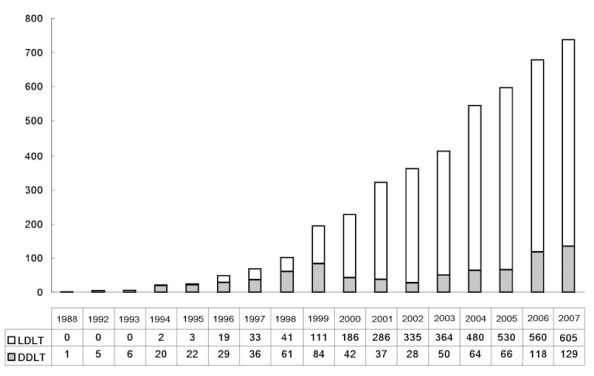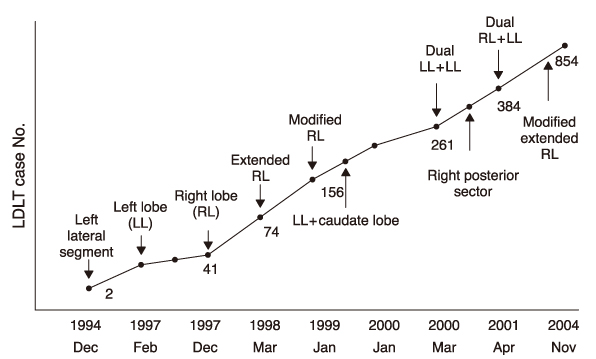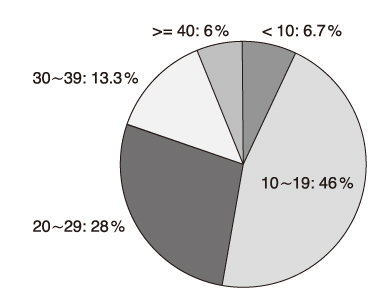J Korean Med Assoc.
2008 Aug;51(8):700-707. 10.5124/jkma.2008.51.8.700.
Current Status and Perspectives of Living Donor Liver Transplantation
- Affiliations
-
- 1Division of Liver Transplantation and Hepatobiliary Surgery, University of Ulsan College of Medicine, Korea. sglee2@amc.seoul.kr
- KMID: 2185926
- DOI: http://doi.org/10.5124/jkma.2008.51.8.700
Abstract
- Living donor liver transplantation (LDLT) has been an established treatment modality for patients with end- stage liver diseases, especially in countries with scarcity of deceased donors. The annual number of LDLT cases in Korea has been steeply increasing, exceeding that of Japan and even doubling that of United States in 2007. When comparing LDLT and deceased donor liver transplantation (DDLT), the timely availability and quality of liver grafts are superior in LDLT, but there are definite drawbacks from anatomical sharing of 1 liver organ by 2 individuals as well as potential donor risk. Biliary complications seem to be the most intractable problems following adult LDLT. The indications for LDLT are nearly identical to those of DDLT. The optimal timing for performing LDLT is not clearly defined, but an earlier transplantation is often recommended before serious worsening of general conditions. The post - transplant management following LDLT is often more difficult than that of DDLT although early liver regeneration makes the liver graft large enough. Current situation in Korea requires a heavy demand on DDLT, but it is still very difficult to expect a rapid rise of deceased donor number within a few years. Thus, LDLT may continue to play the pivotal role to compensate for the serious shortage of deceased donor organs. Coercion to living donors should be prohibited in any situation. The medical team and our whole society should pay special attention to caring of living donors in order to encourage organ donation.
Keyword
MeSH Terms
Figure
Cited by 1 articles
-
Experiences of physical complications and sequelae among living liver donors
Sun Ju Jeong, Han Na Kim
Korean J Transplant. 2019;33(2):36-45. doi: 10.4285/jkstn.2019.33.2.36.
Reference
-
1. Kim ST. Liver transplantation. Korean J Gastroenterol. 1993. 25:9–17.2. Kim KM, Lee SG, Lee YJ, Park KM, Kim SC, Chun HB, Yoo ES, Ko KS, Han SH, Lee MG, Choi KT, Ko JK, Moon HN. Living related donor liver transplantation in children: indication and clinical outcome. J Korean Pediatr Soc. 1998. 41:622–632.3. Lee SG, Lee YJ, Park KM, Jeon HB, Hwang S, Lee KH, Lee RK, Lee JJ, Jung JH, Choi WY, Choi JW, Ahn CS, Ha TY, Jung HJ, Lee BC, Koh KS, Park SH, Choi KT, Lee YS, Chung YH, Suh DJ, Kim MH, Lee MG, Sung KB, Kim MK, Ha HS, Min PC. Adult-to-adult living donor liver transplantation. J Korean Surg Soc. 1998. 55:719–725.4. Lee SG, Hwang S, Park KM, Kim KH, Ahn CS, Lee YJ, Cheon JY, Joo SH, Moon DB, Joo CW, Min PC, Koh KS, Han SH, Choi KT, Hwang KS. Seventeen adult-to-adult living donor liver transplantations using dual grafts. Transplant Proc. 2001. 33:3461–3463.
Article5. Liu CL, Fan ST. Adult-to-adult live-donor liver transplantation: the current status. J Hepatobiliary Pancreat Surg. 2006. 13:110–116.
Article6. Hwang S, Lee SG, Ha TY, Ahn CS, Park KM, Kim KH, Lee YJ, Moon DB, Kim KK, Kim YD. Simplified standardized technique for living donor liver transplantation using left liver graft plus caudate lobe. Liver Transpl. 2004. 10:1398–1405.
Article7. Brown RS Jr, Russo MW, Lai M, Shiffman ML, Richardson MC, Everhart JE, Hoofnagle JH. A survey of liver transplantation from living adult donors in the United States. N Engl J Med. 2003. 348:818–825.
Article8. Lo CM. Complications and long-term outcome of living liver donors: a survey of 1,508 cases in five Asian centers. Transplantation. 2003. 75:S12–S15.
Article9. Wiederkehr JC, Pereira JC, Ekermann M, Porto F, Kondo W, Nagima I, Amaral W, Camargo CA, Moreira M. Results of 132 hepatectomies for living donor liver transplantation: report of one death. Transplant Proc. 2005. 37:1079–1080.
Article10. Akabayashi A, Slingsby BT, Fujita M. The first donor death after living-related liver transplantation in Japan. Transplantation. 2004. 77:634.
Article11. Hwang S, Lee SG, Lee YJ, Sung KB, Park KM, Kim KH, Ahn CS, Moon DB, Hwang GS, Kim KM, Ha TY, Kim DS, Jung JP, Song GW. Lessons learned from 1,000 living donor liver transplantations in a single center: how to make living donations safe. Liver Transpl. 2006. 12:920–927.
Article12. Imura S, Shimada M, Ikegami T, Morine Y, Kanemura H. Strategies for improving the outcomes of small-for-size grafts in adult-to-adult living-donor liver transplantation. J Hepatobiliary Pancreat Surg. 2008. 15:102–110.
Article13. Hwang S, Lee SG, Sung KB, Park KM, Kim KH, Ahn CS, Lee YJ, Lee SK, Hwang GS, Moon DB, Ha TY, Kim DS, Jung JP, Song GW. Long-term incidence, risk factors, and management of biliary complications after adult living donor liver transplantation. Liver Transpl. 2006. 12:831–838.
Article14. Kasahara M, Egawa H, Takada Y, Oike F, Sakamoto S, Kiuchi T, Yazumi S, Shibata T, Tanaka K. Biliary reconstruction in right lobe living-donor liver transplantation: Comparison of different techniques in 321 recipients. Ann Surg. 2006. 243:559–566.15. Liu CL, Lo CM, Chan SC, Fan ST. Safety of duct-to-duct biliary reconstruction in right-lobe live-donor liver transplantation without biliary drainage. Transplantation. 2004. 77:726–732.
Article16. Hwang S, Lee SG, Ahn CS, Kim KH, Moon DB, Ha TY, Song GW, Jung DH, Park JI, Ryu JH, Lee HJ, Suh DJ, Lim YS. Prevention of hepatitis B recurrence after living donor liver transplantation: primary high-dose hepatitis B immunoglobulin monotherapy and rescue antiviral therapy. Liver Transpl. 2008. 14:770–778.
Article17. Yi NJ, Suh KS, Cho JY, Kwon CH, Lee KW, Joh JW, Lee SK, Kim SI, Lee KU. Recurrence of hepatitis B is associated with cumulative corticosteroid dose and chemotherapy against hepatocellular carcinoma recurrence after liver transplantation. Liver Transpl. 2007. 13:451–458.
Article18. Park JI, Choi KM, Lee SG, Hwang S, Kim KH, Ahn CS, Moon DB, Chung YH, Lee YS, Suh DJ. Clinical outcome after living donor liver transplantation in patients with hepatitis C virus-associated cirrhosis. Korean J Hepatol. 2007. 13:543–555.
Article19. Hwang S, Lee SG, Kim KK, Kim KH, Ahn CS, Moon DB, Ha TY, Song GW. Efficacy of 6-month pretransplant abstinence for patients with alcoholic liver disease undergoing living donor liver transplantation. Transplant Proc. 2006. 38:2937–2940.
Article20. Mazzaferro V, Regalia E, Doci R, Andreola S, Pulvirenti A, Bozzetti F, Montalto F, Ammatuna M, Morabito A, Gennari L. Liver transplantation for the treatment of small hepatocellular carcinomas in patients with cirrhosis. N Engl J Med. 1996. 334:693–699.
Article21. Sugawara Y, Tamura S, Makuuchi M. Living donor liver transplantation for hepatocellular carcinoma: Tokyo University series. Dig Dis. 2007. 25:310–312.
Article22. Ito T, Takada Y, Ueda M, Haga H, Maetani Y, Oike F, Ogawa K, Sakamoto S, Ogura Y, Egawa H, Tanaka K, Uemoto S. Expansion of selection criteria for patients with hepatocellular carcinoma in living donor liver transplantation. Liver Transpl. 2007. 13:1637–1644.
Article23. Lee SG, Hwang S, Moon DB, Ahn CS, Kim KH, Sung KB, Ko GY, Park KM, Ha TY, Song GW. Expanded indication criteria of living donor liver transplantation for hepatocellular carcinoma at one large-volume center. Liver Transpl. 2008. 14:935–945.
Article24. Lee SG, Ahn CS, Kim KH. Which types of graft to use in patients with acute liver failure? (A) Auxiliary liver transplant (B) Living donor liver transplantation (C) The whole liver. (B) I prefer living donor liver transplantation. J Hepatol. 2007. 46:574–578.25. O'Grady JG, Alexander GJ, Hayllar KM, Williams R. Early indicators of prognosis in fulminant hepatic failure. Gastroenterology. 1989. 97:439–445.26. Herrero JI, Lorenzo M, Quiroga J, Sangro B, Pardo F, Rotellar F, Alvarez-Cienfuegos J, Prieto J. De novo neoplasia after liver transplantation: an analysis of risk factors and influence on survival. Liver Transpl. 2005. 11:89–97.
Article27. Gruttadauria S, Vizzini G, Biondo D, Mandalá L, Volpes R, Palazzo U, Gridelli B. Critical use of extended criteria donor liver grafts in adult-to-adult whole liver transplantation: a single-center experience. Liver Transpl. 2008. 14:220–227.
Article28. Silberhumer GR, Pokorny H, Hetz H, Herkner H, Rasoul-Rockenschaub S, Soliman T, Wekerle T, Berlakovich GA, Steininger R, Muehlbacher F. Combination of extended donor criteria and changes in the model for end-stage liver disease score predict patient survival and primary dysfunction in liver transplantation: a retrospective analysis. Transplantation. 2007. 83:588–592.
Article29. Cameron AM, Ghobrial RM, Yersiz H, Farmer DG, Lipshutz GS, Gordon SA, Zimmerman M, Hong J, Collins TE, Gornbein J, Amersi F, Weaver M, Cao C, Chen T, Hiatt JR, Busuttil RW. Optimal utilization of donor grafts with extended criteria: a single-center experience in over 1000 liver transplants. Ann Surg. 2006. 243:748–753.
- Full Text Links
- Actions
-
Cited
- CITED
-
- Close
- Share
- Similar articles
-
- Liver retransplantation for adult recipients
- Current Status of Liver Transplantation in Korea
- Current status of hepatic surgery in Korea
- Unilateral Versus Bilateral Biliary Drainage for Post-Transplant Anastomotic Stricture
- Left at right heterotopic implantation of left liver graft in adult-to-adult living donor liver transplantation: the technical concern for decision-making






